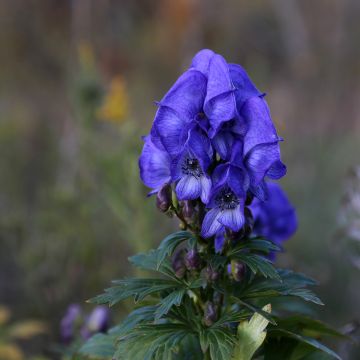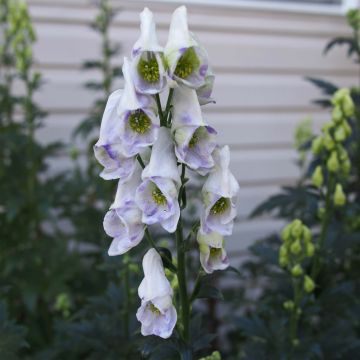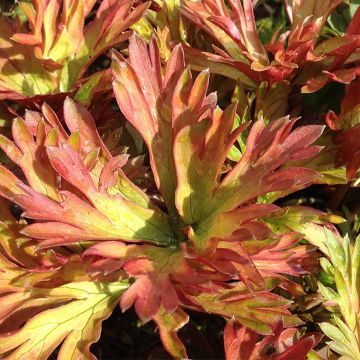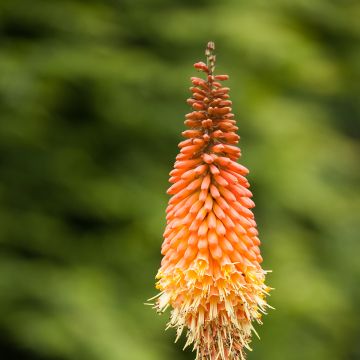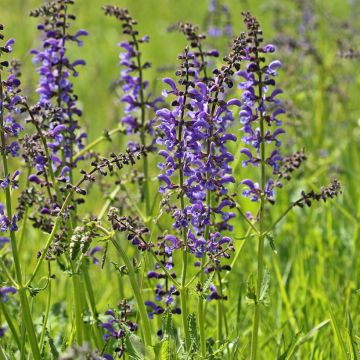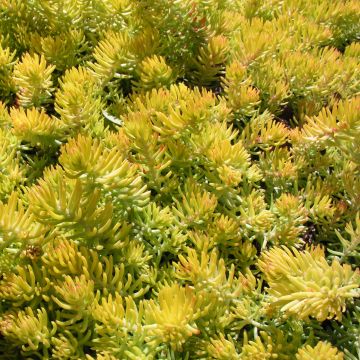

Aconitum cammarum Eleonora
Aconitum cammarum Eleonora
Aconitum x cammarum Eleonora
Monkshood
This plant carries a 12 months recovery warranty
More information
We guarantee the quality of our plants for a full growing cycle, and will replace at our expense any plant that fails to recover under normal climatic and planting conditions.
From €5.90 for pickup delivery and €6.90 for home delivery
Express home delivery from €8.90.
Does this plant fit my garden?
Set up your Plantfit profile →
Description
The Aconitum 'Eleonora' is a hybrid aconite with an upright and compact habit, adorned with a delightful and long summer flowering of subtly nuanced white with hints of blue. This rare and elegant variety produces spikes that slightly bend under the weight of well-stacked flowers, resembling an ancient helmet, towering over a clump of thick and beautifully palmate leaves. Thriving in moist to wet and rich soils, this perennial is a beautiful plant for gently sunny borders, partial shade, or even not too dense shade.
The Aconitum x cammarum 'Eleonora' is a horticultural variety, belonging, like all aconites, to the Ranunculaceae family. The flowering plant measures approximately 60 cm (24in) in height, with a width of 30 to 40 cm. This deciduous perennial, highly resistant to cold, emerges from the ground in spring and disappears underground in winter. The abundant flowering of this variety begins in June and lasts until August. Clumps of leaves emerge from numerous branched, vertical, green-coloured flower stalks. Its elongated flowers, shaped like a helmet, have a pale yellow throat, with a corolla in a broken white shade edged with soft blue-purple. This plant develops from a fleshy tuberous stump, from which an erect clump of sparsely hairy stems emerges in spring, adorned with tough, palmate leaves deeply lobed along the edges. The leaves have pronounced veins and a slightly glossy bright green colour. All parts of this perennial are highly toxic.
Aconites suffer from a bad reputation in gardens due to their legendary toxicity, which is quite regrettable because these favorites of botanical gardens have their place in all gardens with moist soil. They are robust, very hardy, and their foliage is among the most beautiful among perennial plants. Not to mention their dazzling flowering, ranging from almost white to gentian blue. They are perfect for borders, alongside delphiniums, asters, ligularias, and rodgersias, for example. They can be planted among bushes, with Japanese anemones, especially this Eleonora variety, which appreciates light shade. Like foxgloves, they are good perennials or clear and fresh woodland areas. Finally, their flowers are beautiful in bouquets.
Report an error about the product description
Aconitum cammarum Eleonora in pictures


Flowering
Foliage
Plant habit
Safety measures
Botanical data
Aconitum
x cammarum
Eleonora
Ranunculaceae
Monkshood
Cultivar or hybrid
ingestion
Cette plante est toxique si elle est ingérée volontairement ou involontairement.
Ne la plantez pas là où de jeunes enfants peuvent évoluer, et lavez-vous les mains après l'avoir manipulée.
Pensez à conserver l'étiquette de la plante, à la photographier ou à noter son nom, afin de faciliter le travail des professionnels de santé.
Davantage d'informations sur https://plantes-risque.info
Other Aconitum
Planting and care
The 'Eleonora' aconites thrive in the morning sun or in clear woodland, in a sheltered position from strong winds. They appreciate a deep, moist soil, rich in humus, acidic to neutral, or without excessive limestone. In full sun, the soil should be constantly moist and never dry out. For this reason, it is recommended to use a summer mulch to maintain some freshness. The soil that welcomes the aconites will be enriched with compost, leaf soil and turf, which will give it a slight acidity. However, this variety is quite accommodating and will thrive in a good garden soil that remains cool in summer.
Planting period
Intended location
Care
This item has not been reviewed yet - be the first to leave a review about it.
Summer flowering perennials
Haven't found what you were looking for?
Hardiness is the lowest winter temperature a plant can endure without suffering serious damage or even dying. However, hardiness is affected by location (a sheltered area, such as a patio), protection (winter cover) and soil type (hardiness is improved by well-drained soil).

Photo Sharing Terms & Conditions
In order to encourage gardeners to interact and share their experiences, Promesse de fleurs offers various media enabling content to be uploaded onto its Site - in particular via the ‘Photo sharing’ module.
The User agrees to refrain from:
- Posting any content that is illegal, prejudicial, insulting, racist, inciteful to hatred, revisionist, contrary to public decency, that infringes on privacy or on the privacy rights of third parties, in particular the publicity rights of persons and goods, intellectual property rights, or the right to privacy.
- Submitting content on behalf of a third party;
- Impersonate the identity of a third party and/or publish any personal information about a third party;
In general, the User undertakes to refrain from any unethical behaviour.
All Content (in particular text, comments, files, images, photos, videos, creative works, etc.), which may be subject to property or intellectual property rights, image or other private rights, shall remain the property of the User, subject to the limited rights granted by the terms of the licence granted by Promesse de fleurs as stated below. Users are at liberty to publish or not to publish such Content on the Site, notably via the ‘Photo Sharing’ facility, and accept that this Content shall be made public and freely accessible, notably on the Internet.
Users further acknowledge, undertake to have ,and guarantee that they hold all necessary rights and permissions to publish such material on the Site, in particular with regard to the legislation in force pertaining to any privacy, property, intellectual property, image, or contractual rights, or rights of any other nature. By publishing such Content on the Site, Users acknowledge accepting full liability as publishers of the Content within the meaning of the law, and grant Promesse de fleurs, free of charge, an inclusive, worldwide licence for the said Content for the entire duration of its publication, including all reproduction, representation, up/downloading, displaying, performing, transmission, and storage rights.
Users also grant permission for their name to be linked to the Content and accept that this link may not always be made available.
By engaging in posting material, Users consent to their Content becoming automatically accessible on the Internet, in particular on other sites and/or blogs and/or web pages of the Promesse de fleurs site, including in particular social pages and the Promesse de fleurs catalogue.
Users may secure the removal of entrusted content free of charge by issuing a simple request via our contact form.
The flowering period indicated on our website applies to countries and regions located in USDA zone 8 (France, the United Kingdom, Ireland, the Netherlands, etc.)
It will vary according to where you live:
- In zones 9 to 10 (Italy, Spain, Greece, etc.), flowering will occur about 2 to 4 weeks earlier.
- In zones 6 to 7 (Germany, Poland, Slovenia, and lower mountainous regions), flowering will be delayed by 2 to 3 weeks.
- In zone 5 (Central Europe, Scandinavia), blooming will be delayed by 3 to 5 weeks.
In temperate climates, pruning of spring-flowering shrubs (forsythia, spireas, etc.) should be done just after flowering.
Pruning of summer-flowering shrubs (Indian Lilac, Perovskia, etc.) can be done in winter or spring.
In cold regions as well as with frost-sensitive plants, avoid pruning too early when severe frosts may still occur.
The planting period indicated on our website applies to countries and regions located in USDA zone 8 (France, United Kingdom, Ireland, Netherlands).
It will vary according to where you live:
- In Mediterranean zones (Marseille, Madrid, Milan, etc.), autumn and winter are the best planting periods.
- In continental zones (Strasbourg, Munich, Vienna, etc.), delay planting by 2 to 3 weeks in spring and bring it forward by 2 to 4 weeks in autumn.
- In mountainous regions (the Alps, Pyrenees, Carpathians, etc.), it is best to plant in late spring (May-June) or late summer (August-September).
The harvesting period indicated on our website applies to countries and regions in USDA zone 8 (France, England, Ireland, the Netherlands).
In colder areas (Scandinavia, Poland, Austria...) fruit and vegetable harvests are likely to be delayed by 3-4 weeks.
In warmer areas (Italy, Spain, Greece, etc.), harvesting will probably take place earlier, depending on weather conditions.
The sowing periods indicated on our website apply to countries and regions within USDA Zone 8 (France, UK, Ireland, Netherlands).
In colder areas (Scandinavia, Poland, Austria...), delay any outdoor sowing by 3-4 weeks, or sow under glass.
In warmer climes (Italy, Spain, Greece, etc.), bring outdoor sowing forward by a few weeks.



































